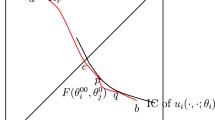Abstract
This paper designs an allotment mechanism for a limited amount of an infinitely divisible good (resource) among a finite number of agents under transferable utility. The mechanism is efficient in the sense of total agents’ utility maximization. As a solution, we introduce an adaptation of the Groves–Ledyard “quadratic government” that was initially suggested for the problem of public good.
Similar content being viewed by others
References
Boss, V., Lektsii po matematike: differentsial’nye uravneniya (Lectures on Mathematics: Differential Equations), Moscow: Editorial URSS, 2004.
Burkov, V.N., Danev, B., Enaleev, A.K., et al., Bol’shie sistemy: modelirovanie organizatsionnykh mekhanizmov (Large Systems: Modeling of Organizational Mechanisms), Moscow: Nauka, 1989.
Burkov, V.N., Dzhavakhadze, G.S., Dinova, N.I., and Shchepkin, D.A., Primenenie igrovogo imitatzionnogo modelirovaniya dlya otsenki effektivnosti ekonomicheskikh mekhanizmov (Application of Game Simulation Modeling for Estimating the Efficiency of Economic Mechanisms), Moscow: Inst. Probl. Upravlen., 2003.
Goubko, M.V. and Novikov, D.A., Teoriya igr v upravlenii organizatsionnymi sistemami (Game Theory and Organizational Systems Control), Moscow: Sinteg, 2002.
Goubko, M.V. and Spryskov, D.S., Consideration of Cooperative Interactions in Planning Mechanisms, Upravlen. Bol’sh. Sist., 2000, no. 2, pp. 28–38.
Iskakov, M.B., Equilibrium in Safety Strategies and Equilibriums in Objections and Counter-objections in Noncooperative Games, Autom. Remote Control, 2008, vol. 69, no. 2, pp. 278–298.
Korgin, N.A., Representing a Sequential Resource Allotment Rule in the Form of a Strategy-proof Mechanism of Multicriteria Active Expertise, Autom. Remote Control, 2014, vol. 75, no. 5, pp. 983–995.
Korgin, N.A. and Khristyuk, A.A., The Effective Mechanism of Active Examination with the Payment for Participation as the Tool of Acceptance of the Coordinated Decisions, Vestn. Voronezh. Gos. Tekh. Univ., 2011, vol. 7, no. 6, pp. 117–121.
Korepanov, V.O. and Novikov, D.A., The Reflexive Partitions Method in Models of Collective Behavior and Control, Autom. Remote Control, 2012, vol. 73, no. 8, pp. 1424–1441.
Mazalov, V.V., Mencher, A.E., and Tokareva, Yu.S., Peregovory. Matematicheskaya teoriya (Negotiations. Mathermatical Theory), St. Petersburg: Lan’, 2012.
Novikov, D.A., Theory of Control in Organizations, New York: Nova Science, 2013.
Arifovic, J. and Ledyard, J.O., A Behavioral Model for Mechanism Design: Individual Evolutionary Learning, J. Econom. Behav. Organiz., 2011, no. 78, pp. 375–395.
Barberá, S., Jackson, M., and Neme, A., Strategy-Proof Allotment Rules, Games Econom. Behav., 1997, vol. 18, no. 1, pp. 1–21.
Basar, T. and Maheswaren, R., Social Welfare of Selfish Agents: Motivating Efficiency for Divisible Resources, Proc. Control Decision Conf. (CDC), 2004, pp. 2004–361.
Boyd, S., Parikh, N., and Chu, E., Distributed Optimization and Statistical Learning via the Alternating Direction Method of Multipliers, Foundat. Trends Machine Learn., 2011, vol. 3, no. 1, pp. 1–122.
Fischbacher, U., z-Tree—Zurich Toolbox for Ready-made Economic Experiments, Experim. Econom., 2007, vol. 10, no. 2, pp. 171–178.
Fudenberg, D. and Levine, D., Theory of Learning in Games, Cambridge: MIT Press, 1999.
Goetz, R., Martinez, Y., and Jofre, R., Water Allocation by Social Choice Rules: The Case of Sequential Rules, Ecol. Econom., 2008, vol. 65, no. 2, pp. 304–314.
Groves, T. and Ledyard, J.O., The Existence of Efficient and Incentive Compatible Equilibria with Public Goods, Econometrica, 1980, no. 6, pp. 1487–1506.
Healy, P. and Mathevet, L., Designing Stable Mechanisms for Economic Environments, Theoret. Econom., 2012, vol. 7, no. 3, pp. 609–661.
Hurwicz, L., Outcome Functions Yielding Walrasian and Lindahl Allocations at Nash Equilibrium Points, Rev. Econom. Stud., 1979, no. 46, pp. 217–225.
Jain, R. and Walrand, J., An Efficient Nash-Implementation Mechanism for Divisible Resource Allocation, Automatica, 2010, vol. 46, no. 8, pp. 1276–1283.
Johari, R. and Tsitsiklis, J.N., Efficiency of Scalar-ParameterizedMechanisms, Oper. Res., 2009, no. 57, pp. 823–839.
Kakhbod, A. and Teneketzis, D., An Efficient Game Form for Unicast Service Provisioning, IEEE Trans. Autom. Control, 2012, vol. 57, no. 2, pp. 392–404.
Kruskal, W.H. and Wallis, W.A., Use of Ranks in One-Criterion Variance Analysis, J. Am. Statist. Ass., 1952. vol. 47, pp. 583–621.
Lefebvre, M., Sharing Rules for Common-Pool Resources When Self-insurance Is Available: An Experiment, Working Papers 11–22, LAMETA, Univ. of Montpellier, 2012.
Maskin, E., The Theory of Nash Equilibrium: A Survey, in Social Goals and Social Organization, Hurwicz, L., Schmeidler, D., and Sonnenschein, H., Eds., Cambridge: Cambridge Univ. Press, 1985, pp. 1985–173.
Mathevet, L., Supermodular Mechanism Design, Theoret. Econom., Econometr. Soc., 2010, vol. 5(3), pp. 403–443.
Moulin, H., An Efficient and Almost Budget Balanced Cost Sharing Method, Games Econom. Behav., 2010, vol. 70, no. 1, pp. 107–131.
Sprumont, Y., The Division Problem with Single-Peaked Preferences: A Characterization of the Uniform Rule, Econometrica, 1991, vol. 59, pp. 509–519.
van Essen, M., A Note on the Stability of Chen’s Lindahl Mechanism, Soc. Choice Welfare, 2012, vol. 38(2), pp. 365–370.
Walker, M., A Simple Incentive Compatible Scheme for Attaining Lindahl Allocations, Econometrica, 1981, no. 49, pp. 65–71.
Author information
Authors and Affiliations
Corresponding author
Additional information
Original Russian Text © N.A. Korgin, V.O. Korepanov, 2013, published in Upravlenie Bol’shimi Sistemami, 2013, No. 46, pp. 216–265.
Rights and permissions
About this article
Cite this article
Korgin, N.A., Korepanov, V.O. An efficient solution of the resource allotment problem with the Groves–Ledyard mechanism under transferable utility. Autom Remote Control 77, 914–942 (2016). https://doi.org/10.1134/S0005117916050131
Received:
Published:
Issue Date:
DOI: https://doi.org/10.1134/S0005117916050131




